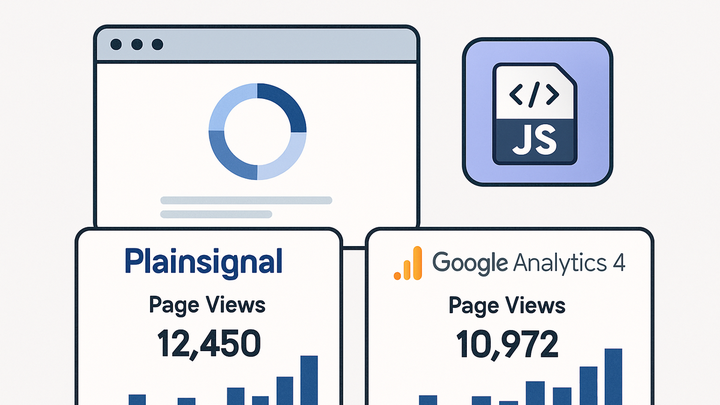Published on 2025-06-22T01:19:27Z
What is a Page View? Examples and Tracking in Analytics
Page views are a core metric in web analytics, tracking every time a web page is loaded or reloaded in a browser. They provide a direct measure of traffic volume and initial engagement, forming the basis for deeper user behavior analysis and content performance evaluation.
Traditional analytics platforms such as Google Analytics 4 (GA4) automatically record page views via cookie-based mechanisms and built-in page_view events. In contrast, privacy-focused, cookie-free solutions like PlainSignal rely on lightweight, server-side fingerprinting to count views without storing identifiers in the user’s browser.
Understanding page views helps businesses gauge marketing effectiveness, optimize user experience, and make data-informed decisions. Advanced implementations also support virtual page views for single-page applications, ensuring that navigation events without full page reloads are accurately captured.
Below, we explore definitions, tracking methods, real-world examples, and best practices for page view analytics.
Page view
A page view counts each instance a page loads or virtual page is triggered, fundamental for measuring web traffic and engagement.
Overview of Page Views
A page view represents each instance a web page is loaded or reloaded in a user’s browser. It serves as the primary unit of measurement for web traffic and engagement. Page views capture full page loads by default, but can also be extended to include virtual or programmatic page changes in single-page applications.
-
Definition
Counts a view every time the browser requests and renders a page or when a virtual pageview is triggered by code.
-
Full page load
Traditional page refresh or initial load counts as one page view.
-
Virtual pageview
Single-page apps can trigger page views via history or custom events.
-
-
Why it matters
Page views provide a baseline metric for analyzing overall site traffic, content popularity, and user behavior trends.
Tracking Page Views
Implementing page view tracking involves embedding analytics JavaScript on your pages. You can choose cookie-based or cookie-free solutions, and account for modern web frameworks.
-
Cookie-based vs. cookie-free tracking
Most traditional analytics rely on cookies to identify repeat views; alternatives like PlainSignal use server-side methods without cookies.
-
Cookie-based tracking
Stores identifiers in the user’s browser to distinguish sessions and repeat visits.
-
Cookie-free tracking (PlainSignal)
Uses lightweight scripts and server-side fingerprints to count page views without cookies.
-
-
Handling single-page applications
SPAs do not reload the page on navigation by default, so you must hook into route changes to log virtual page views.
-
History api events
Listen for pushState and popState events to trigger additional page view calls.
-
Examples with SaaS Tools
See how leading analytics platforms implement page view tracking using code snippets and configurations.
-
Google analytics 4 (GA4)
GA4 automatically tracks page_view events with gtag.js. For manual control or single-page apps, you can send events explicitly:
<script async src="https://www.googletagmanager.com/gtag/js?id=GA_MEASUREMENT_ID"></script> <script> window.dataLayer = window.dataLayer || []; function gtag(){dataLayer.push(arguments);} gtag('js', new Date()); gtag('config', 'GA_MEASUREMENT_ID'); // Manual page view gtag('event', 'page_view', { page_title: document.title, page_location: window.location.href }); </script> -
PlainSignal (cookie-free simple analytics)
PlainSignal offers a lightweight, privacy-friendly snippet to track page views without cookies:
<link rel="preconnect" href="//eu.plainsignal.com/" crossorigin /> <script defer data-do="yourwebsitedomain.com" data-id="0GQV1xmtzQQ" data-api="//eu.plainsignal.com" src="//cdn.plainsignal.com/plainsignal-min.js"></script>This code preconnects for performance and then loads the tracker to log each page view securely.
Best Practices and Common Pitfalls
Optimizing page view tracking ensures data accuracy and privacy compliance. Be mindful of duplicate events, bot traffic, and user consent.
-
Prevent double counting
Debounce tracking calls and avoid duplicate script loads to maintain accurate counts.
-
Filter bot and spam traffic
Implement filters or use built-in bot filtering in analytics tools to exclude non-human visits.
-
Respect privacy regulations
Use cookie-free or anonymized tracking to comply with GDPR, CCPA, and other data privacy laws.
